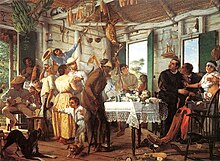
Back Puertorriqueños en los Estados Unidos Spanish Portoricani negli Stati Uniti Italian 푸에르토리코계 미국인 Korean Puerto Ricans in the United States SIMPLE
Puertorriqueños en Estados Unidos | |
|---|---|
 | |
| Total population | |
1.79% of the US population (2023)[2] | |
| Regions with significant populations | |
| Majority concentrated in Florida and the Northeastern United States (New York, Pennsylvania, New Jersey, Connecticut, and Massachusetts) Smaller numbers in other parts of the country, including in Rhode Island, Delaware, Maryland, Virginia, North Carolina, and Georgia in the East, Ohio, Illinois and Wisconsin in the Midwest, Texas in the Southwest, and California and Hawaii out west, among other areas.[3] | |
| Languages | |
| Puerto Rican Spanish, American English and Spanglish | |
| Religion | |
| Christianity (Catholic Church and Protestant) | |
| Related ethnic groups | |
| Taíno, Europeans, Africans, White Latin Americans, Afro-Latin Americans, Mulattos, Mestizos, Latino Americans, White Puerto Ricans, Black Puerto Ricans, Dominican Americans, Cuban Americans. |
| Part of a series on |
| Hispanic and Latino Americans |
|---|
| Part of a series on |
| Puerto Ricans |
|---|
 |
| By region or country |
| Subgroups |
| Culture |
| Religion |
| History |
| Language |
|
|
Stateside Puerto Ricans[4][5] (Spanish: Puertorriqueños en Estados Unidos), also ambiguously known as Puerto Rican Americans (Spanish: puertorriqueño-americanos,[6][7] puertorriqueño-estadounidenses),[8][9] or Puerto Ricans in the United States, are Puerto Ricans who are in the United States proper of the 50 states and the District of Columbia who were born in or trace any family ancestry to the unincorporated US territory of Puerto Rico.[10][11]
Pursuant to the Jones–Shafroth Act, all Puerto Ricans born on the island have US citizenship. At 9.3% of the Hispanic population in the United States, Puerto Ricans are the second largest Hispanic group nationwide after Mexicans, and are 1.78% of the entire population of the United States.[2] Stateside Puerto Ricans are also the largest Caribbean-origin group in the country, representing over one-third of people with origins in the geographic Caribbean region.[12] While the 2020 Census counted the number of Puerto Ricans living in the States at 5.6 million, estimates in 2022 show the Puerto Rican population to be 5.91 million.[2][13][14]
Despite newer migration trends, the New York metropolitan area continues to be the largest demographic and cultural center for Puerto Ricans in the mainland United States, with the Orlando metropolitan area having the second-largest community. The portmanteau "Nuyorican" refers to Puerto Ricans and their descendants in the New York City area. About 67% of the Puerto Rican population in the United States proper resides in either the Northeast or Florida.
- ^ [1]
- ^ a b c "B03001 HISPANIC OR LATINO ORIGIN BY SPECIFIC ORIGIN - United States - 2022 American Community Survey 1-Year Estimates". U.S. Census Bureau. July 1, 2022. Retrieved September 15, 2022.
- ^ "1960 Census: Detailed tables" (PDF). Census.gov. February 14, 2019. pp. 103–104. Retrieved June 10, 2023.
- ^ Atlas of Stateside Puerto Ricans: Abridged Edition without Maps. Angelo Falcon. Puerto Rico Federal Affairs Administration. ca. 2002. Page 3. Retrieved December 13, 2013.
- ^ Promociones SMS y Dibella Entertainment firman al puertorriqueño americano Christopher "Golden" Galeano. BOXEOMUNDIAL.COM. Posted on August 29, 2013.
- ^ La Reforma social: Lessons from the War and the Peace Conference Reforma Social: Revista mensual de cuestiones sociales, Volumes 20–21. p232.
- ^ Yonquis y yanquis salvajes. José Luis Alonso de Santos and César Oliva. p20. Ediciones Castalia. 2012.
- ^ Isabela. Wagner Ortega González. p123. Editorial de la Universidad de Costa Rica. 2005.
- ^ Boxeo Telemundo Regresa el 21 de Junio a las 11:35PM/10:35C con una Segunda Temporada que incluye a Orlanda Cruz y una pelea por el titulo mundial. Archived March 23, 2014, at the Wayback Machine Telemundo Press Release. June 10, 2013.
- ^ "Stateside". Collins Online Dictionary. Glasgow, Scotland: HarperCollins Publishers. 2019. Retrieved September 6, 2019.
- ^ Five million Puerto Ricans now living in the mainland U.S.[usurped] Caribbean Business. June 27, 2013. Vol 41. Issue 24. Retrieved December 13, 2013.
- ^ "Table 1. First, Second, and Total Responses to the Ancestry Question by Detailed Ancestry Code: 2000". U.S. Census Bureau. Retrieved June 9, 2013.
- ^ Llorente, Elizabeth (June 21, 2013). "Salvadorans Overtaking Cubans As Third-Largest Hispanic Group In The U.S." FoxNews.com. Retrieved January 20, 2017.
- ^ "1.5 million Dominicans live in the U.S.: Pew study". dominicantoday.com. June 20, 2013. Archived from the original on June 24, 2013. Retrieved January 20, 2017.